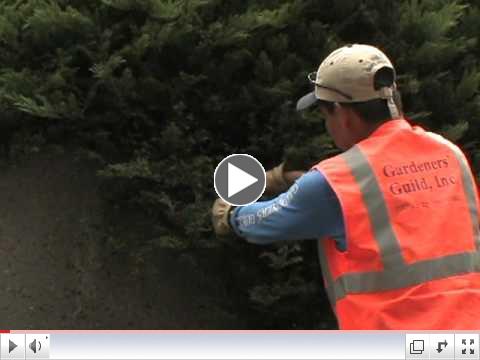 |
Point of View
with
Employee Owner
Marco Preciado
|
"From the time I get up in the morning - I'm motivated. It is so important to be positive and Gardeners' Guild is such a positive place to work. It feels like family. My boss and co-workers work as a team. We take care of our clients' properties as if it was our own home."
Marco is a Crew Leader in our Exterior Maintenance Division in San Francisco. His projects include residential and commercial high rises.
|
|
Can this Boxwood be saved?
|
You can tell by the photo that this Boxwood is old. And, foliage is only growing on outer branches This severely restricts air and light, making it susceptible to diseases. It will need to be pruned back hard. After a proper thinning bare areas will be exposed to light. If the plant is healthy it will grow leaves on the newly exposed branches. The next couple of years will tell whether this Boxwood can be saved. It's hard to tell from the photo, but there are some yellow leaves. This could mean a fungus. Depending on the severity of the pest, it may be more practical to replace the Boxwood.
|

 | See the video on our sustainable program!
|
|
|
|
|
Greetings!
Hortculturalist Alex Niemiera of Virginia Tech researched the impact of landscaping on the value of a home. He found that it could increase its value from 5% to 12.7%. On a $400,000 home 5.5% is $22,000; 12.7% adds $50,800. Not too shabby. Conversely, a degraded or disorganized collection of plants can actually detract from a home's value. Bob Vila says that the biggest mistake homeowners make is a lack of a coherent plan.
Some professionals recommend that a homeowner should plan on budgeting 10% of a home's value on landscaping. More than how much, say all industry analysts, it is best to have a consistent theme and a long term or master plan for your landscape.
Just like your roof, siding, asphalt; insulation, your landscape has a useful lifespan. What does your landscape say about your property?
 Gardeners' Guild Inc.
|
|
Landscape Management
Don't leave it to chance

This term refers to a broad spectrum of activities that your landscape will need to maximize its lifespan.
Jerry Goodspeed, a Horticulturalist for Utah State University says that in the first five years of a landscape plants grow and fill in their asigned area.
After ten years, he says plants become outgrown and crowding can become a problem. When shrubs are in decline may also become leggy and need some hard pruning to restore their vigor.
At this time you'll want to evaluate each plant on a case by case basis, some may need replacing, others might be saved. A professional can help you to identify which trees or shrubs should be removed and develop a plan for enhancement.
Some important factors to consider:
Irrigation and water management: an irrigation system installed more than ten years ago may be wasting water and costing you money.
Turf areas: they are an expensive portion of your landscape. Part of long term management is regular aeration. Top dressing with organic products will improve soil making your turf more resilient.
Long term tree care: Routine pruning and fertilization are important for the health of your trees - an important part of your asset. With the proper maintenance, your large trees will last for many years.
Managing plant growth: Part art; part science, plants are competing for nutrients, water and sunlight and some do not survive. Once a young tree matures, its canopy may block the sunlight from a neighboring plant making its removal necessary. Or, rather than shearing a shrub that is crowding another plant, a more healthy solution can be to selectively remove plants crowing each other.
|
|
Strategic Planning

This is a plan that gives you a 50,000 foot view of your landscape over a period of 1 to 10 years.
Start with a template. Excel is a good software program to use for developing a long term plan. We use it for our clients and it has been very successful. These are some important expenditure categories: - Trees care planning
- Shrubs
- Turf areas
- Pruning
- Fertilization
- Mulch
- Aeration and dethatching
- Irrigation
- Annual color (if applicable)
- Integrated Pest Management
Estimate when some of the above will start to degrade and put a budget number to it. A rule of thumb - the useful lifespan for large shrubs or small trees is 7 to 10 years. But, this can be exceeded when the proper plant is in the right place and with skilled maintenance.
Your plan is a road map to achieving your goal and staying on a budget that works for you. Do you have a vision of a major renovation for your landscape? Put it in the plan. The beauty of it is you can phase in big changes and adjust - and you have your basic needs covered.
Get advice - the life expectancy of your landscape and the condition of your plants are subject to changing weather conditions and location. Are you close to the bay? Is your property urban or rural? Stress of poor soils; pests, irrigation - under or over irrigation or fertilization and impact the life of your plants. A professional will help you sort through these factors.
Call us with questions.
|
|
Myths about Drip Irrigation

Source for this article is an green industry trade publication and it illuminates some commonly held myths about drip.
Myth 1 - Shallow watering produces shallow roots:
All plants, particularly grass survive only by developing a deep root system. Frequent watering with an overhead sprinkler system will encourage a shallow root system. Whereas - a drip system waters more deeply into the soil, encouraging a deeper root system.
Myth 2 - Root intrusion is a major problem with drip systems:
New sub service irrigation systems use state of the art technology like physical and chemical barriers to block root intrusion. All plants, particularly grass survive only by developing a deep root system.
Myth 3 - Drip requires more water:
Drip delivers water more slowly, directly to the root zone which is why it has longer run times. This eliminates the wasted water which occurs with overhead sprinkler systems.
Myth 4 - You can't install drip in an area that is already planted:
It is more convenient to do so, but there is equipment that is used just for that purpose.
Myth 5 - You can't tell if it is working as it is underground:
When your system is not working you can tell because the area is either too wet or dry. You can also feel around the soil for moisture levels
|
|
|
|
|